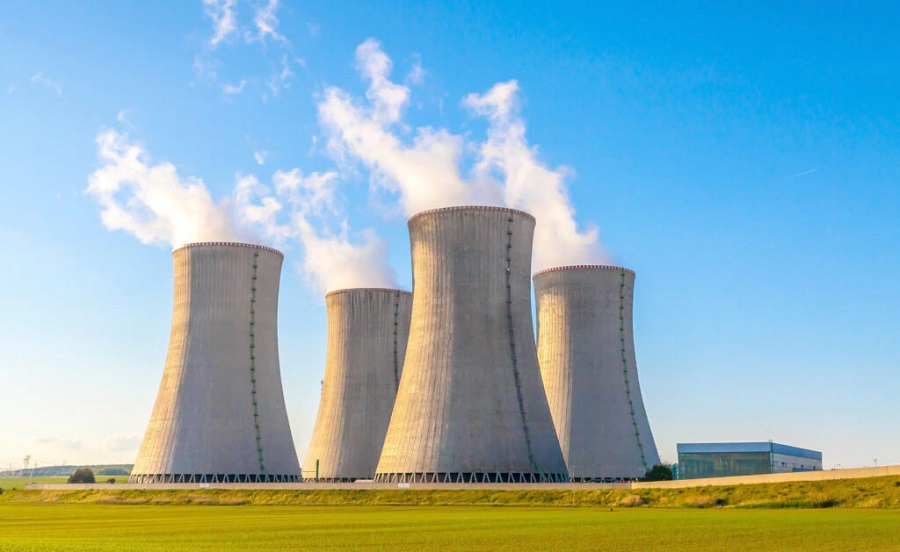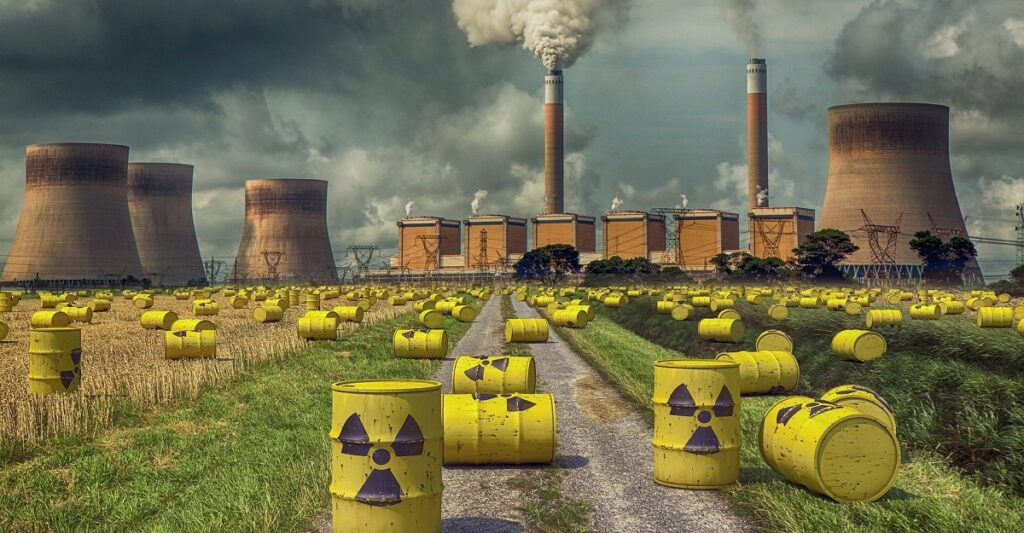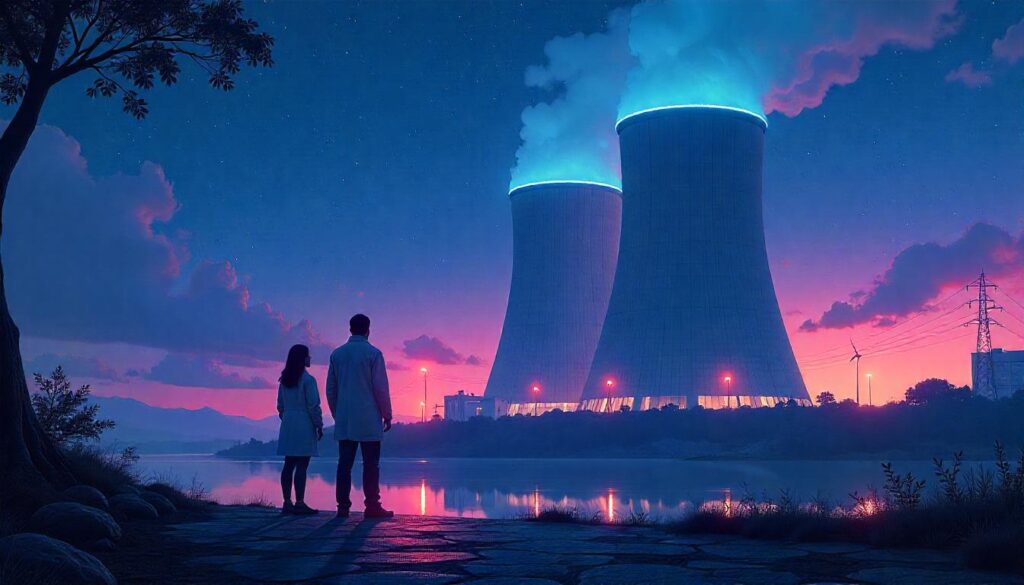One of the greatest advantages of nuclear energy — which accounts for approximately 10% of global electricity production — is that it does not directly release CO2 (carbon dioxide) into the atmosphere.
Even when analyzing its life cycle, considering emissions linked to uranium extraction or the concrete used in plants, it produces very few greenhouse gases. Far less than gas, coal, or even, surprisingly, less than solar energy itself. Nuclear energy is projected to grow in most forecasts and scenarios presented by UN climate experts (IPCC), and it has the potential to limit global warming to 1.5°C by the end of the 19th century.

Thus, the IAEA (International Atomic Energy Agency) has raised its projections for the first time since 2011, when the Fukushima disaster occurred. It now predicts that installed nuclear capacity will double by 2050 in the most favorable scenario.
Nuclear energy faces opposition
Scientists from the IPCC also acknowledge that the future deployment of nuclear energy may be greatly constrained by current societal preferences. In some countries, it continues to have a negative perception due to various risks of disasters and the issue of long-lived radioactive waste.
In EU meetings, divisions are so pronounced that they intensify debates on whether to consider the nuclear sector as an environmentally and climate-rewarding activity. Germany decided to progressively phase out this energy source, replacing its plants with variable renewables and natural gas, largely influenced by the Fukushima disaster. However, the current energy crisis caused by the invasion of Ukraine has forced the German government to delay the closure of its two remaining nuclear plants: Isar 2 and Neckarwestheim 2.
There is also no unanimity among the public. Central European nations like the Czech Republic regard nuclear energy as a reliable and relatively cheap source of electricity, embarking on projects to build more nuclear plants for large-scale electricity generation.
Nuclear energy requires the least mineral extraction
Nuclear energy requires the least mineral extraction to produce a given amount of electricity, as highlighted in a recent report by the IEA (International Energy Agency).
Additionally, the Joint Research Centre (JRC) reveals that “analyses of this energy demonstrate that key measures to prevent radiological impacts from uranium extraction, nuclear plant operation, and radioactive waste treatment can be implemented using existing technology at reasonable costs.”
They also confirm that “the storage of high-level, long-lived waste in geological formations is an appropriate and safe method to isolate them from the biosphere over very long timescales.”
Radioactive waste footprint and poor management
Despite the reports from the IEA and research by the JRC on measures to mitigate the radiological impacts of radioactive waste, it is undeniable that storage costs and its environmental footprint cannot be overlooked.
The Spanish public entity responsible for managing, collecting, transporting, and storing these hazardous wastes, Enresa, published its 2020 annual report. It stated that low, very low, and intermediate-level wastes (LILW), which have a half-life of no more than 30 years, were stored in a total volume of 2,374.57 m³. Of this, 2,277.35 m³ came from nuclear power plants.
On the other hand, the management of high-level wastes (HLW) and spent fuel (SF)—those with a very long half-life, spanning thousands of years—is currently carried out in on-site pools at nuclear power plants in Spain. This will continue until the 7th General Plan for Radioactive Waste Management (currently under review) defines future strategies. According to Enresa’s national inventory, in 2018, Spain generated 7,500 m³ of HLW and SF.

Radioactive waste: A legacy for the future?
According to evaluations in the 6th Radioactive Waste Management Plan and Enresa’s 2020 annual report, managing the by-products from nuclear plants is projected to cost €15.195 billion from 2021 to 2100. The report does not account for costs beyond this timeframe. A portion of this expense is funded through the “Enresa fee,” which nuclear plant owners pay for waste management. The remainder is covered by all electricity consumers through their utility bills.
Through Law 54/1997 of the Electricity Sector, the Spanish government increased the Enresa fee by 19.28% in 2019, raising the cost to €7.98 per MWh generated by nuclear plants. Notably, this fee had not been revised since 2010. The new rate, alongside other fees, boosted Enresa’s net annual revenues to €468 million in 2020. These funds are allocated not only to waste management but also to the decommissioning of facilities and budgets for municipalities hosting nuclear plants.
Additionally, according to Enresa’s 2020 report, a significant portion of the by-products was exported to France. This required a daily deposit of €76,618, amounting to a total of €96 million in 2020. By 2021, this figure rose to €110 million.
Nuclear energy for the EU’s energy transition
Currently, for the conglomerate of countries in the European Union, nuclear energy provides 26% of electricity production. Moreover, it is estimated that electricity generation will need to double over the next 30 years. Considering the ongoing energy transition and the current state of nuclear power plants, the European Commissioner for the Internal Market, Thierry Breton, has presented a proposal.
This proposal seeks to classify natural gas and nuclear energy as green and essential for decarbonizing the economy. Breton mentions that experts forecast the share of nuclear energy to drop to less than 15% by 2050.
However, due to the growing demand for electricity and its exponential increase in the coming years, the commissioner insists on increasing nuclear energy production, especially considering that some of the older plants are set to close in the near future.
To address this, he advocates for including “nuclear in the taxonomy to attract the necessary investments” and predicts an intense competition for investors among various energy sources. Finally, Breton highlights the need for:
- 65 billion euros annually for renewable energy.
- 45 billion euros annually for network infrastructure.
- A 500-billion-euro investment in new atomic reactors by 2050.

The disparities in criteria among countries, industries, and organizations regarding the economic, social, and environmental feasibility of exploiting nuclear energy for electricity production are undeniable. The challenges, particularly in terms of safety and waste management, are significant. However, the current energy crisis underscores its importance as an intermediate step to reduce emissions from more polluting sources while renewable energies continue to be developed.